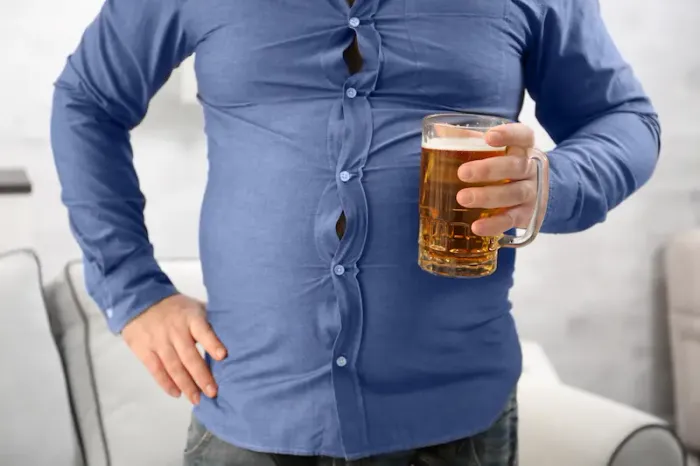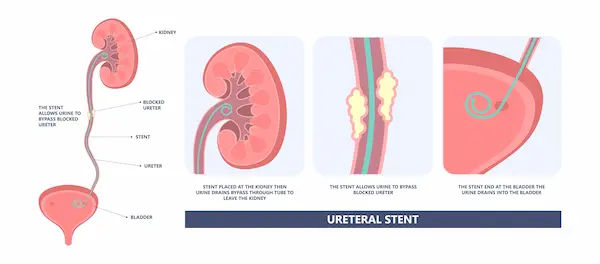Beer Belly: Health Risks You Should Know
Learn about the health risks associated with a beer belly, including heart disease, diabetes, and lifestyle changes to reduce abdominal fat.

Written by Dr. Md Yusuf Shareef
Reviewed by Dr. Rohinipriyanka Pondugula MBBS
Last updated on 12th Sep, 2025

Introduction
The term "beer belly" is often used with a chuckle, a harmless label for the rounded abdomen that can come with a fondness for brews. But beneath this casual nickname lies a serious medical reality. A beer belly isn't just subcutaneous fat, the soft, pinchable layer under your skin. It's a significant deposit of visceral fat, a metabolically active tissue that wraps around your internal organs and acts as a hormone-producing organ itself, often for the worse. This article moves beyond the myth to explore the genuine health risks associated with a beer-induced waistline. We'll dissect what it is, why it's dangerous, and how it's linked to severe conditions like heart disease, diabetes, and liver failure. More importantly, we'll provide a clear roadmap for reclaiming your health, proving that understanding these risks is the first step toward a longer, healthier life.
What Exactly Is a "Beer Belly"? It's Not What You Think
Many people think a beer belly comes just from beer, but it’s actually about fat distribution, lifestyle, and metabolism.
Beer Belly vs. General Obesity: Spot the Difference
Not all weight gain is created equal. General obesity involves fat distributed throughout the body on the hips, thighs, arms, and face. A beer belly, scientifically known as central or abdominal obesity, is characterised by fat accumulation primarily in the abdominal area. This creates a distinctive apple-shaped body type. The key difference isn't just location; it's the type of fat and its profound impact on your health.
The Science of Visceral Fat: Your Body's Active Enemy
Visceral fat is not an inert storage unit. It's biologically active, pumping out inflammatory chemicals and hormones like cytokines and free fatty acids directly into your portal vein, which carries blood to your liver. This constant release:
• Increases insulin resistance, a precursor to type 2 diabetes.
• Disrupts normal hormone function, including leptin (which regulates hunger).
• Raises blood pressure and negatively alters cholesterol levels.
• This is why two people with the same Body Mass Index (BMI) can have vastly different health profiles; the one with more visceral fat is at a far greater risk.
Consult a Bariatrician for the best advice
The Top 5 Health Risks Linked to Excessive Beer Consumption
Drinking too much beer can impact your health in several serious ways; here are the five most important risks to be aware of.
1. Metabolic Syndrome and Type 2 Diabetes
Metabolic syndrome is a cluster of conditions of increased blood pressure, high blood sugar, excess body fat around the waist, and abnormal cholesterol levels that occur together, drastically increasing your risk of heart disease, stroke, and diabetes. Visceral fat is a primary driver of this syndrome. The inflammation it causes makes your body's cells resistant to insulin, the hormone that regulates blood sugar. This forces your pancreas to work overtime, eventually leading to burnout and the development of type 2 diabetes.
2. Cardiovascular Disease: Heart Attacks and Strokes
The link between a beer belly and heart disease is well-established. Visceral fat contributes to:
• Hypertension (High Blood Pressure): Inflammatory substances constrict blood vessels.
• Atherosclerosis: It raises LDL ("bad") cholesterol and lowers HDL ("good") cholesterol, leading to plaque buildup in arteries.
3. Liver Damage: From Fatty Liver to Cirrhosis
Your liver is your body's primary processing plant for alcohol. Excessive beer consumption overloads it, forcing it to prioritise alcohol metabolism over its other jobs, like processing fats. This leads to a buildup of fat in liver cells, known as alcoholic fatty liver disease, an early yet reversible stage of liver damage. Continued abuse can progress to alcoholic hepatitis (inflammation) and eventually cirrhosis, where scar tissue replaces healthy tissue, causing permanent, life-threatening liver failure.
4. Increased Cancer Risk
The World Health Organisation has classified alcohol as a Group 1 carcinogen, the same category as asbestos and tobacco. The health risks include a significantly higher chance of developing cancers of the mouth, throat, esophagus, liver, colon, and breast. The mechanisms are varied, including the conversion of alcohol into acetaldehyde (a toxic chemical that damages DNA), oxidative stress, and impaired nutrient absorption.
5. Hormonal Imbalances and Sleep Disruption
Beer can wreak havoc on your endocrine system. In men, it can lower testosterone levels and increase oestrogen, sometimes leading to conditions like gynaecomastia. It also spikes the stress hormone cortisol, which further promotes abdominal fat storage. Furthermore, while alcohol may help you fall asleep faster, it severely disrupts the REM and deep sleep cycles, leaving you fatigued and compounding health issues like poor recovery and increased stress.
Why Does Beer Specifically Cause Belly Fat?
Beer can lead to belly fat because its calories and sugars are easily stored as fat, especially around the abdomen.
The Calorie Conundrum: Empty Calories Add Up
Beer is calorie-dense. A standard pint of regular beer contains around 150-200 calories, almost entirely from carbohydrates and alcohol; these are "empty calories" with minimal nutritional value. It's very easy to consume multiple drinks in one sitting, adding 500-1000 extra calories to your daily intake without realising it. These excess calories are stored as fat, with a high propensity for the abdominal area.
The Insulin Effect: How Alcohol Impacts Fat Storage
When you consume alcohol, your body recognises it as a toxin and prioritises metabolising it above all else, including burning fat and sugar. This process disrupts your normal metabolic pathways. Furthermore, the carbohydrates in beer cause a spike in blood sugar and insulin, a hormone that promotes fat storage. With your body busy processing the alcohol, these sugars are more likely to be converted into fat and stored, often viscerally.
Diagnosis: How Do You Know If Your Belly Fat is Dangerous?
Excess belly fat can signal serious health risks. Here’s how doctors assess whether your fat levels could affect your health.
Waist-to-Hip Ratio: A Simple At-Home Test
A quick way to assess your risk is to calculate your Waist-to-Hip Ratio (WHR).
1. Measure your waist at its narrowest point (usually just above the navel).
2. Measure your hips at their widest point.
3. Divide your waist measurement by your hip measurement.
A WHR above 0.90 for men and 0.85 for women indicates abdominal obesity and an increased risk of obesity-related conditions.
When to See a Doctor: Recognising the Red Flags
If you're experiencing symptoms beyond weight gain, such as persistent fatigue, shortness of breath, high blood pressure, or unexplained aches, it's crucial to seek professional advice. They can order blood tests to check cholesterol, liver enzymes, and blood sugar levels. Apollo24|7 offers a convenient home collection for tests like liver function tests (LFT) or HbA1c, making it easier to get a clear picture of your health.
Get Your Health Assessed
Reversing the Trend: How to Lose a Beer Belly and Improve Health
With the right diet, exercise, and lifestyle changes, you can reduce belly fat and boost your overall health.
Dietary Changes: It's Not Just About Quitting Beer
The most effective step is reducing or eliminating alcohol consumption. However, diet is paramount. Focus on:
• Whole Foods: Prioritise lean proteins, fibrous vegetables, and complex carbohydrates.
• Sugar Reduction: Cut out sugary drinks and processed snacks, which contribute to fat storage similarly to alcohol.
• Hydration: Drink plenty of water to aid metabolism and reduce false hunger cues.
The Role of Exercise: Why Cardio Isn't Enough
A combination of cardio and strength training is ideal.
• Cardiovascular Exercise (running, swimming, cycling) burns calories and improves heart health.
• Strength Training (weightlifting, resistance bands) builds muscle mass. Muscle is metabolically active tissue, meaning it burns more calories at rest, helping to combat insulin resistance and reduce visceral fat over time. You cannot spot-reduce belly fat, but a full-body approach will target it effectively.
Lifestyle Modifications: Sleep and Stress Management
Prioritising 7-9 hours of quality sleep per night helps regulate the hormones ghrelin and leptin, which control appetite. Managing stress through meditation, yoga, or hobbies can lower cortisol levels, preventing the cycle of stress-induced cravings and abdominal fat storage.
Conclusion: A Call for Mindful Consumption
A beer belly is far more than a cosmetic issue; it's a clear external sign of internal health risks. The visceral fat it represents is a key player in developing life-altering diseases like diabetes, heart failure, and cancer. Understanding that beer contributes to this through empty calories, metabolic disruption, and hormonal changes is the first step toward mitigation. The path to better health isn't necessarily about complete abstinence for everyone, but rather about mindful consumption, a nutrient-rich diet, consistent exercise, and proper sleep. By taking proactive steps today, including consulting a healthcare professional for personalised advice, you can significantly reduce these risks and invest in a healthier, longer future.
Consult a Bariatrician for the best advice
Consult a Bariatrician for the best advice

Dr. Anand Ravi
General Physician
2 Years • MBBS
Bengaluru
PRESTIGE SHANTHINIKETAN - SOCIETY CLINIC, Bengaluru

Dr. Sunil Kaul
General Surgeon
30 Years • MBBS, MS, FICS, FIMSA, FMAS
Delhi
Apollo Hospitals Indraprastha, Delhi
(25+ Patients)

Dr. Kiran K J
General and Laparoscopic Surgeon
18 Years • MBBS, MS, FMAS, DMAS (Fellow & Dip in Min. Access surg.), FALS- Bariatric & Robotic Surgery
Bengaluru
Apollo Hospitals Bannerghatta Road, Bengaluru
(175+ Patients)

Dr. Saket Goel
General Surgeon
27 Years • MBBS, MS (Surg.)
Delhi
Apollo Hospitals Indraprastha, Delhi
(125+ Patients)

Dr. Nikhilesh Krishna
Bariatrician
7 Years • MS, FMAS, FALBS
Chennai
Apollo Hospitals Greams Road, Chennai
Consult a Bariatrician for the best advice

Dr. Anand Ravi
General Physician
2 Years • MBBS
Bengaluru
PRESTIGE SHANTHINIKETAN - SOCIETY CLINIC, Bengaluru

Dr. Sunil Kaul
General Surgeon
30 Years • MBBS, MS, FICS, FIMSA, FMAS
Delhi
Apollo Hospitals Indraprastha, Delhi
(25+ Patients)

Dr. Kiran K J
General and Laparoscopic Surgeon
18 Years • MBBS, MS, FMAS, DMAS (Fellow & Dip in Min. Access surg.), FALS- Bariatric & Robotic Surgery
Bengaluru
Apollo Hospitals Bannerghatta Road, Bengaluru
(175+ Patients)

Dr. Saket Goel
General Surgeon
27 Years • MBBS, MS (Surg.)
Delhi
Apollo Hospitals Indraprastha, Delhi
(125+ Patients)

Dr. Nikhilesh Krishna
Bariatrician
7 Years • MS, FMAS, FALBS
Chennai
Apollo Hospitals Greams Road, Chennai
More articles from General Medical Consultation
Frequently Asked Questions
1. Is non-alcoholic beer a better option for avoiding a beer belly?
Non-alcoholic beer has significantly fewer calories and eliminates the metabolic disruption caused by alcohol, making it a much better choice for weight management. However, some brands still contain sugars, so it's important to check labels.
2. Can you get rid of a beer belly by just doing ab exercises?
No. Spot reduction is a myth. While ab exercises strengthen your core muscles, they won't burn the layer of visceral fat covering them. Losing abdominal fat requires a full-body approach through a calorie deficit created by diet and overall exercise.
3. How long does it take to lose a beer belly?
It varies based on your starting point, diet, and consistency. With significant changes, you may see noticeable results in 2-3 months. However, reducing visceral fat can show health improvements (like lower blood pressure) even before a major visual change.
4. Are some people genetically predisposed to a beer belly?
Yes, genetics can influence where your body stores fat. Some individuals are more prone to storing fat in the abdominal area (apple shape) than in the hips and thighs (pear shape). However, lifestyle choices remain the dominant factor.
5. Does the type of beer matter?
Craft beers and imperial stouts can have double or triple the calories of a standard light lager. While switching to a lower-calorie option can help, the total volume of alcohol consumed is the most critical factor for your health risks and calorie intake




.webp)


